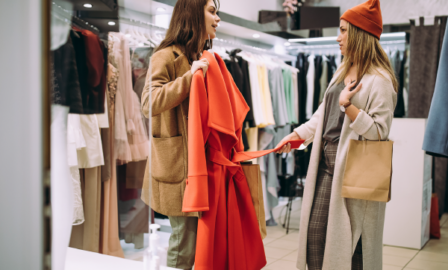How Gen Z is Reshaping the Luxury Retail Market
Shifting customer preferences and priorities are reshaping the luxury retail market, with Gen Z and Millennial customers leading the way. Luxury retailers have noticed an increase in young shoppers and are adapting their strategies accordingly to better engage with this new market. Studies show that younger generations are entering the luxury retail market earlier than ever before, with Gen Z buying their first luxury products at 15 years old – three to five years earlier than Millennials.
This generational shift is influencing trends focused on sustainability, reducing overconsumption, and brand value. Social media, in particular, has played a role in driving Gen Z’s purchasing decisions and exposing them to luxury retail brands in real time. Below, we explore how Gen Z is reshaping the luxury retail market and how luxury brands are evolving to cater to the demands of these younger shoppers.
Influential Consumer Behavior & Key Demographics
Customers under age 40 now comprise 40% of the luxury consumer base, and this demographic tends to advocate for both sustainability and value. Many of these customers make purchasing decisions based on a brand’s environmental and ethical principles, making it more important than ever for brands to make these an internal priority.
A growing number of customers are prioritizing uniqueness and exclusivity in the products they purchase. Collectors, particularly those looking for limited-edition, vintage items, are increasingly turning to secondhand markets to find pieces with a “history.” All of these shifts in customer behavior and priorities are pushing the expansion of the secondhand luxury retail market.
Social Media’s Impact
Social media has played an essential role in this shift, as Gen Z’s ubiquitous access to platforms like Instagram and TikTok leads to easier exposure to luxury brands. Influencer marketing through social media has played a large role in Gen Z’s rising interest in luxury brands. Through collaborations with popular influencers, luxury brands have extended their reach to younger generations. For instance, Louis Vuitton collaborated with Emma Chamberlain, and the partnership was valued at $16 million.
Prada is another company that has tried to recruit Gen Z through social media. The brand released a collaboration with Snapchat, allowing users to customize their Bitmojis with Prada collection items. This is just another example of how brands can increase Gen Z’s exposure to and interest in their brand as they start to step into the luxury retail market.
These platforms have also made it easier to hold brands accountable. For example, Marc Jacobs said he was “bullied” out of using fur for his designs after a runway show Fendi collaboration involved fox fur hats. The incident spread across social media, sparking protests. The anti-fur movement resulted in Marc Jacobs making a statement against the use of fur and many other fashion brands to remove fur from their products.
Gen Z has demonstrated a push for ethical products. Now, political, environmental and social issues are all factors that brands must increasingly consider in the manufacturing and campaign processes. Negative publicity, especially calls to boycott specific brands, can quickly pick up speed online, pushing luxury brands to align themselves with customer values.
How Luxury Brands are Engaging with this Market
Secondhand Market
While Gen Z has been increasingly engaging with the luxury retail market via social media platforms, they don’t always have the funds to afford luxury goods. This has led to a rise in secondhand buying, as about 30% of Gen Z shop secondhand to purchase higher-end brands.
With the secondhand market growing in popularity, leading luxury brands are seeking innovative ways to stay relevant and connected with their consumers. Some retailers are embracing the change by establishing their own secondhand storefronts or partnering with reCommerce sites, not only to promote sustainability but to encourage shoppers to reinvest in their brand. Gucci was one of the pioneering brands, establishing a partnership with TheRealReal, an online secondhand storefront, to offer pre-loved Gucci items. Similarly, Burberry has teamed up with the Vestiaire Collective to offer gift cards in exchange for used Burberry products.
Luxury retailer FarFetch has taken its partnership to the next level through its collaboration with Thrift+. When customers purchase a used bag from Thrift+, they’ll receive a FarFetch gift card as well as a charity donation made in their name, blending philanthropic values with sustainable initiatives. We also see brands entering the secondhand market on their own. Coachtopia is an initiative by Coach that uses reused and recycled materials to offer second-chance sales of past collections. All these efforts represent a collective and conscious effort from luxury retailers to meet demands for sustainability without compromising on exclusivity.
Events
Outside of resale initiatives, luxury brands are redefining their value through premium experiences. A survey found that 73% of 18-35 year olds plan to attend live events in the next six months. This demonstrates a push amongst Gen Z and Millennials towards in-person events. Companies like Louis Vuitton and IWC Schaffhausen have targeted this market, hosting private concerts and celebrity meet-and-greets with limited access to a select group willing to pay the high price. Many of these membership-only events also rely on modern technology, such as NFTs, to heighten their appeal. For instance, customers can purchase a digital token for around $41,600 to access a limited-edition Louis Vuitton collection. Initiatives like this allow luxury retailers to better protect and reinforce their premium status in the changing market.
Digital Experiences
In addition to offering in-person experiences, many luxury brands also offer phygital and digital experiences, utilizing new technology to help reach the younger tech-savvy generations and enhance the customer experience. Gucci has used augmented reality tools in a partnership with Snapchat to allow users to virtually try on their shoes with a filter.
Luxury brands have also been creating gamified content to gain exposure to younger audiences. For example, Gucci collaborated with Roblox to push their products to Gen Z. The brand released “Gucci Town,” a virtual destination in Roblox where players can shop Gucci fashion to customize their avatar. This gamification has caught the attention of shoppers, particularly among younger generations.
This enhancement of the customer experience helps to pull in Gen Z customers who have been shown to value the experience of luxury shopping as much as the product itself. In order to attract the rising number of Gen Z luxury shoppers, brands should focus on ways they can utilize technology to enhance customer experience.
Affordable Products
Many luxury brands are also adding cosmetic lines, which are typically priced lower than their fashion lines. These lower price-point products can act as a gateway for Gen Z to afford their first luxury items. For example, Dior’s lip oil line went viral on TikTok, gathering the attention of Gen Z. Cosmetics can often be priced under $100, fitting more easily into Gen Z’s budget. For luxury brands like Dior, Chanel, and YSL Beauty, fragrances, lipsticks and other cosmetics can help reach Gen Z shoppers. Gaining the attention of Gen Z early can help luxury brands earn their brand loyalty for future and more expensive purchases.
Looking Ahead
As the luxury market continues to endure this transition phase, retailers must be proactive in adapting to new preferences while maintaining their exclusivity and integrity. The rise of Gen Z shoppers highlights the need for luxury retailers to find innovative strategies to keep pace with their competitors.
If you’re looking for ways to adapt your company to these shifting luxury retail trends, Clarkston can help.
Subscribe to Clarkston's Insights
Contributions by Natalie Pollock



